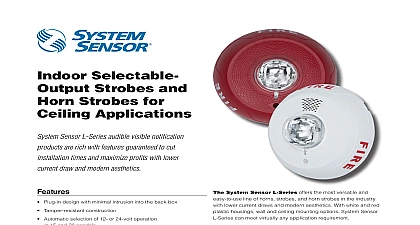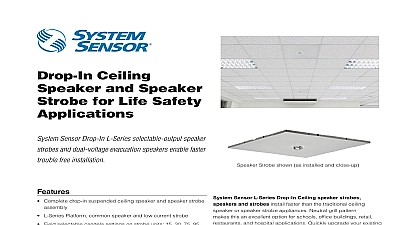System Sensor Successfully Deploying FAAST in Cold Storage Applications

File Preview
Click below to download for free
Click below to download for free
File Data
| Name | system-sensor-successfully-deploying-faast-in-cold-storage-applications-9864150723.pdf |
|---|---|
| Type | |
| Size | 1.28 MB |
| Downloads |
Text Preview
White Paper 2011 Deploying FAAST Fire Alarm Aspiration Sensing Technology Cold Storage Applications Successfully Deploying FAAST Fire Alarm Aspiration Sensing Technology In Cold Storage Applications Protecting Cold Storage Facilities of the most difficult environments to protect from fire and smoke damage is cold storage facilities Very often due to the low temperatures the UL listings for many traditional detection devices do not allow them to be used in cold storage facilities Humidity issues and high airflows can complicate fire protection for these applications smoke detectors such as the System Sensor FAAST 8100 are often well suited to hot cold or other extreme conditions because the ports can be run through a pipe network into the difficult space while the device is mounted in a remote location protected from extreme In addition because it actively samples the air FAAST works well in high airflow environments aspirated smoke detectors such as FAAST can often be a solution for these cold storage spaces temperature airflow condensation and differential issues must be considered and resolved as necessary This whitepaper provides guidelines for using the FAAST 8100 device to cold storage facilities particularly for pipe selection and design Storage Overview are several types of cold storage applications In fact the temperatures within a cold storage facility can vary between 40 and 18 lowest of these temperatures can prove challenging for any smoke detector Figure 1 provides temperature ranges for common cold storage 1 Cold Storage Application Temperatures Material and Design sample pipe used for a cold storage application should be selected based on local codes and the lowest temperature expected for the space and PVC are commonly used for sample pipe materials outside of the cold storage space yet are not capable of withstanding the extreme temperatures of freezers operating below 20 ABS PE copper and stainless steel pipe of appropriate size are all acceptable for cold due to their ability to withstand low temperatures Copper and stainless pipe have the added advantage of enabling heat tracing cable be used along the pipe outside the space see Tracing below for more information All metallic pipe should be properly grounded to avoid buildup that is common with continuous airflow Plastic pipe must be used at the FAAST intake and exhaust ports for a proper seal with the FAAST Never cement sample pipe to the FAAST unit itself 2 Pipe Recommendations for Various Temperatures Temperature to 80 40 to 176 to 60 58 to 140 to 60 58 to 140 to 93 15 to 200 to 49 15 to 120 to 110 238 to 230 Material the proper pipe has been selected to suit the temperature of the cold storage application there are several standards codes and guidelines should be followed when designing a sampling pipe network to work appropriately in cold storage applications the application pipe condensation will occur on any surface that drops below dew point temperature Condensation or frosting on the diameter ID of the pipe that can lead to clogging will only occur if the pipe experiences a drop in temperature to the dew point temperature along its length This dew point temperature is often a few degrees below the cold space operating temperature For this reason every should be made to keep the pipe away from local temperature fluctuations within the space wherever possible Hole Spacing and Orientation standards or codes commonly dictate sample hole spacing or coverage area for aspirated or spot smoke detection devices according to a level of protection For example NFPA 76 specifies spacing guidelines and threshold settings for warning and early warning fire These same spacing requirements would apply within cold storage yet as noted above cold storage has a few more limitations related to and frost conditions that can have an impact on pipe and sample hole locations The following provides further guidelines for designing pipe networks for cold storage applications Sensor Advanced Ideas Advanced Solutions Successfully Deploying FAAST Fire Alarm Aspiration Sensing Technology In Cold Storage Applications all sample holes facing sideways in freezer applications Sample holes facing the floor are more prone to frost buildup and clogging the event moisture collects within the pipe thru traffic and other conduits for added moisture can quickly raise RH levels resulting in condensation and frost issues within a sub application This added moisture in the air will first and foremost show as frost around sample holes near the doorway or supply vent to be avoided during pipe design sample holes appropriately to avoid the warm moist air entering from access doors Sample holes nearest these locations should face from the access door and be no smaller than 1 8 inch diameter piping should not be positioned anywhere in the supply air stream The supply air for cold storage can be 20 degrees cooler than the space operating temperature Pipes mounted in front of the cold air supply can experience frosting at sample hole locations Any sample located within the vicinity of the supply air should be at least 1 8 inch diameter and face 90 degrees from the floor Wrapping the pipe in at this location can help avoid frost on the pipe ID When installing the insulation leave a 20 mm gap in the insulation at the sample location The insulation must then be fastened in place with hose clamps to prevent it from moving and covering the sample hole Sample in these locations should be no smaller than 1 8 inch diameter Where possible sample holes should be placed near the return air location of the cooling unit The cooling unit will actively pull air over the hole The sample holes should be positioned on the side of the pipe facing into the direction of flow sample tubes should be avoided in cold storage due to smaller tube diameter and the downward facing sample holes Traps traps are often installed outside the space to protect against moisture buildup Condensation rarely occurs on the inside surface of a pipe when exits the cold space however When the cool dry air is warmed outside the cold space its dry bulb temperature is warming and moving further the dew point temperature The dew point temperature is based on the moisture content in the cold space and remains constant as the air warms the length of the pipe Condensation will only occur if the sample pipe experiences a drop in temperature below that of the cold space itself drop in temperature can happen if the sample pipe is located near an outside door in the winter months Heat pipes exiting cold storage must be long enough to raise the temperature to 0 for the detector Use of an external heater cable can be useful the external pipe length is too short to warm the air prior to the detector or condensation on the exterior of the pipe is causing moisture related on the exterior of the pipe Refer to the charts below to determine an approximate length of pipe required under ambient conditions 3 CPVC Figure 4 Seamless Copper Tubing sch40 CPVC Type M Seamless Copper Tubing L min L min L min L min L min L min Length ft Length ft Tracing of a heater cable on the pipe outside the space can help raise sample air temperature as well as minimize the amount of moisture condensing on outside of the pipe This excessive condensation can cause an unhealthy situation with slippery floors or fungus growth The use of a low power cable can help minimize pipe length and potentially unhealthy condensation One such cable is the Chromalox SRL 5 1CT self heater cable This type of cable is capable of actively regulating power along its length based on pipe temperature This can provide some security against condensation both inside and outside the pipe external to the cold space Penetrations wall penetrations must be sealed well against any air leakage over the long term Moist outside air will migrate into a freezer through th


